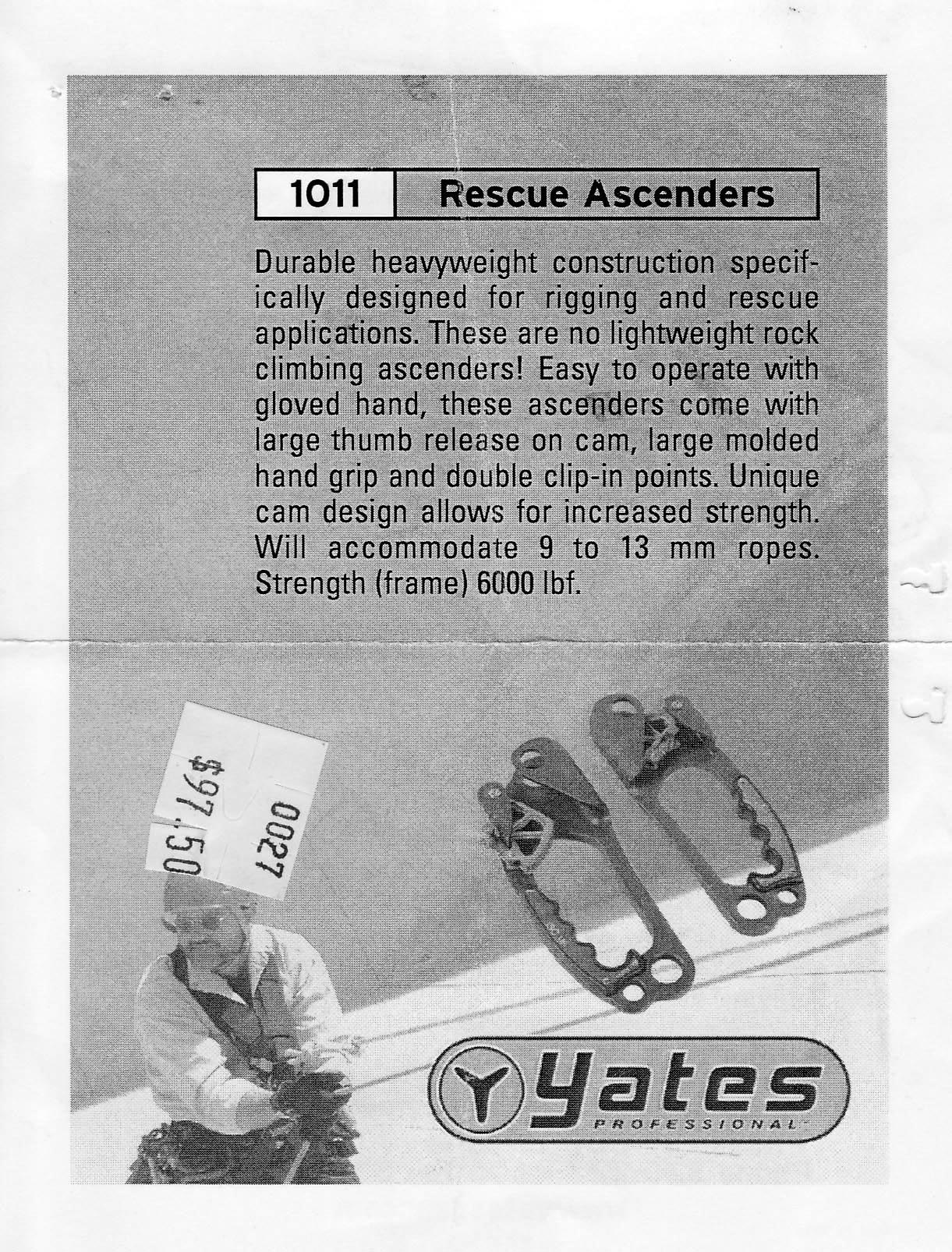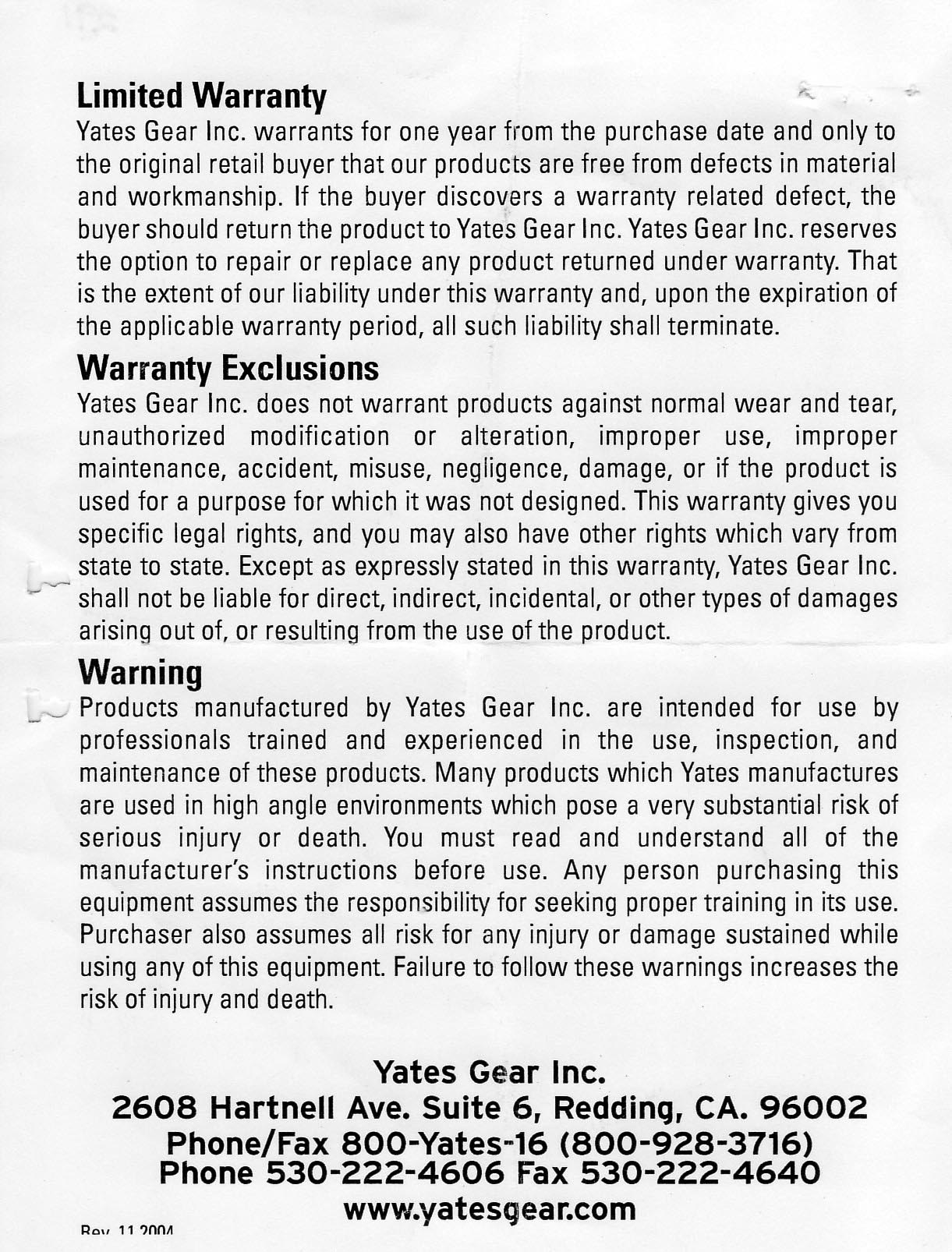Technical Details
I acquired a right-handed Yates Big Wall ascender from Acme Climbing in 2009. I acquired a pair in 2017 as part of Bob Thrun’s collection.
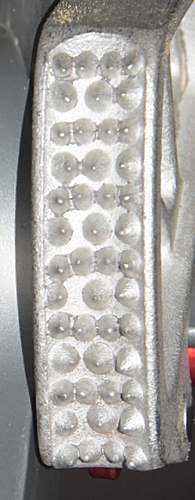 The Yates is essentially the same as the ISC
Big Wall, Version B ascender (it is even marked "ISC" instead of "Yates," but it came with Yates documentation), so I only got one of each. My Yates Big Wall is 217 mm. tall, 84 mm. wide, 32 mm. thick, and weighs 370 g. The shell is milled from a custom aluminum extrusion and hard-coated.
The extrusion and overall rounded shape of the ascender are similar
to the S.R.T. A1 Explorer. Like the S.R.T. (and the C.M.I.),
the extrusion direction is oriented parallel to the vertical axis
of the ascender, and contains two opposing channels. One channel
is rounded and becomes the rope channel; the other is square
and holds the cam. The rope channel is 15 mm. wide. The angled hand hole is roomy, and a rubberized
plastic grip with aluminum insets is riveted to the frame. A 20 mm.
hole and a 13.5 mm. hole are drilled at the bottom and a 16.2 by 20 mm. hole is
milled through both sides of the rope channel. The hand hole is
made a little wider than on the C.M.I. 5000, so the rope channel barely protrudes from the ascender body
as on the C.M.I. 5000 series and S.R.T. Caver/climber series.
The Yates is essentially the same as the ISC
Big Wall, Version B ascender (it is even marked "ISC" instead of "Yates," but it came with Yates documentation), so I only got one of each. My Yates Big Wall is 217 mm. tall, 84 mm. wide, 32 mm. thick, and weighs 370 g. The shell is milled from a custom aluminum extrusion and hard-coated.
The extrusion and overall rounded shape of the ascender are similar
to the S.R.T. A1 Explorer. Like the S.R.T. (and the C.M.I.),
the extrusion direction is oriented parallel to the vertical axis
of the ascender, and contains two opposing channels. One channel
is rounded and becomes the rope channel; the other is square
and holds the cam. The rope channel is 15 mm. wide. The angled hand hole is roomy, and a rubberized
plastic grip with aluminum insets is riveted to the frame. A 20 mm.
hole and a 13.5 mm. hole are drilled at the bottom and a 16.2 by 20 mm. hole is
milled through both sides of the rope channel. The hand hole is
made a little wider than on the C.M.I. 5000, so the rope channel barely protrudes from the ascender body
as on the C.M.I. 5000 series and S.R.T. Caver/climber series.
The cam is a plated skeletonized, reinforced stainless steel
casting with a (4.3)^6(4) conical tooth count. The cam radius increases from 42 to 61 mm. over an angle of 41°, giving a 24° cam angle. The tooth axes
are perpendicular to the cam face. The teeth are well-formed. The
cam, cam spring, and a cam housing are mounted on a 5 mm.
semi-tubular rivet. The cam housing is a piece of thin sheet metal bent
to cover the top of the cam channel and serve as a spacer along
the sides of the cam. The top of the housing is flat instead of
indented (compare it with the S.R.T. Caver/climber
series). The cam safety is a spring-loaded piece of 3 mm.
red anodized aluminum mounted on a 3 mm. stainless steel
rivet placed through two tabs on the base of the cam. A small
thumb knob is staked to the safety. The knob is turned to give
a contoured grip. The safety is placed so that it does not interfere
with one’s hand in the handle.
The front of the rope channel has a milled up-pointing arrow. The back of the frame is etched "08/220/8472." The aluminum inset
on the front side of the grip is marked with an arrow pointing
up, an ISC logo, and "0120CE."
The rear inset is marked "ø ROPE MIN9mm-13mm MAX."
Although the Yates and ISC
Big Wall, Version B are the same design made by the same company, my original Yates was made a year later than my ISC
Big Wall, Version B. I immediately noticed that the cam teeth on the Yates are not as nice as the ones on the older ISC. The ICS teeth were all nicely made, evenly spaced, and separated, while the teeth on the Yates are uneven, sometimes crooked, and occasionally run together. They still work, but are not as pretty. Bob’s Yates were made a year before mine, and the teeth on his looked like those on the ISC
Big Wall, Version B.
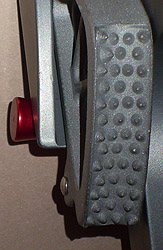
ISC Cam |
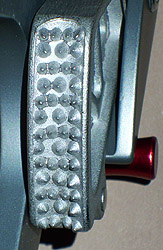
Yates Cam |
Observant readers will notice that the rivet holding the ISC
Big Wall, Version B cam safety has a round head, while the one on the Yates is countersunk.
For far more content, use a larger monitor and a full-width window.
Hundreds of cell phone users complained and asked me to for a simpler, mobile friendly site. In particular, they wanted me to limit each page to a small number of pictures and minimize my use of text. This new site provides what they asked for.


